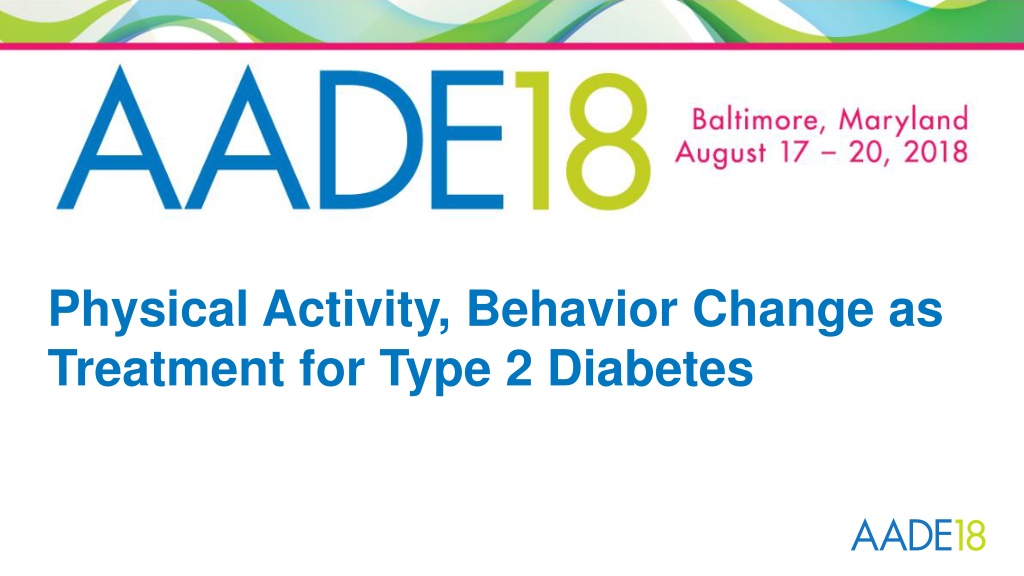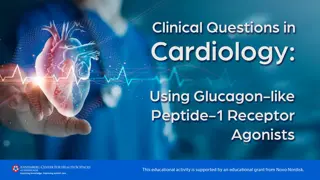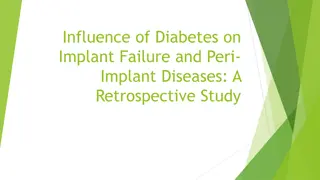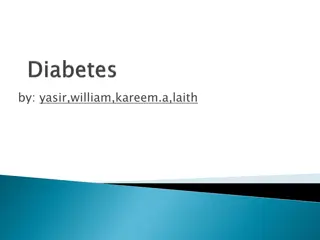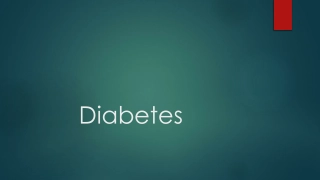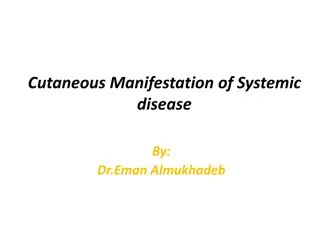Behavior Change for Type 2 Diabetes Management
Discover the impact of physical activity and behavior change in treating Type 2 diabetes. Learn about current trends, team management approaches, and the importance of understanding behavior change to improve outcomes for individuals. Centered on self-efficacy, this insightful session sheds light on practical strategies to enhance health and well-being in diabetes management.
Download Presentation
Please find below an Image/Link to download the presentation.
The content on the website is provided AS IS for your information and personal use only. It may not be sold, licensed, or shared on other websites without obtaining consent from the author. Download presentation by click this link. If you encounter any issues during the download, it is possible that the publisher has removed the file from their server.
Presentation Transcript
Physical Activity, Behavior Change as Treatment for Type 2 Diabetes
Introduction Director of Strategic Partnerships American Council on Exercise San Diego, CA MS Exercise Physiology ACE Youth Fitness Specialist ACE Spokesperson MFA Education Committee Member Anthony J Wall, MS, CPT
Disclosure to Participants Notice of Requirements For Successful Completion Please refer to learning goals and objectives Learners must attend the full activity and complete the evaluation in order to claim continuing education credit/hours Conflict of Interest (COI) and Financial Relationship Disclosures: Presenter: Anthony J Wall, CPT, MS - No COI/Financial Relationship to disclose Non-Endorsement of Products: Accredited status does not imply endorsement by AADE, ANCC, ACPE or CDR of any commercial products displayed in conjunction with this educational activity Off-Label Use: Participants will be notified by speakers to any product used for a purpose other than for which it was approved by the Food and Drug Administration.
Agenda Introductions and Current Trends Using Behavior Change to increase Physical Activity Principles in Exercise Programming for Individuals with Type 2 Diabetes Translating Recommendations into Action - Activity Recap and wrap up
Current Trends 30.3 million people in the US have diabetes 25% of adults are unaware they have diabetes 90% of individuals with prediabetes are unaware More than 5,000 children each year develop type 2 diabetes
Centered on Self-Efficacy An individual s belief in his or her capacity to execute behaviors necessary to produce specific performance attainments. -American Psychological Association
Rooted in Empathy The ability to step into the shoes of another person, aiming to understand their feelings and perspectives, and to use that understanding to guide our actions. -greatergood.berkeley.edu
Positive Psychology The aim of Positive Psychology is to begin to catalyze a change in the focus of psychology from a preoccupation with only repairing the worst things in life to also building positive qualities. -Seligman & Csikszentmihalyi
A Practice in Positive Psychology Part I: Write at least 3-4 sentences describing your best possible self in the future. Within your description address topics such as family, friends, health, career and/or hobbies, imagining the best case scenario for this outcome. Part II: Working in pairs, take turns sharing your descriptions with one another. Take brief notes after sharing your summary and after listening to your partner s summary describing your experience.
Barriers to Increasing Physical Activity Lack of facilities Lack of resources Lack of time * Low energy Fear of hypoglycemia Perceived effort Physical discomfort* Boring nature of exercise*
Building an Exercise Program Plan ahead; get all necessary approvals, waivers, etc. Communicate with patient s primary care physician Inform participants that they will be doing physical activity Start with walking Build in resistance training over time
Starting an Exercise Program Communicate with the client s primary care physician Know client s PA interests, strengths, goals & challenges Keep a daily log Consider exercise as medicine Invest in appropriate footwear Explore non-traditional opportunities to increase physical activity
Cardio Exercise Programming (FITT) Frequency: 4-5 days/week, preferably daily - do not go more than 2 days in a row without cardiovascular/aerobic exercise Intensity: Zone 1 with brief periods in Zone 2 - using ACE 3-Zone Model Time: 30-60 mins/session Type: Low impact aerobic exercise supplemented by an increased NEAT
NEAT ways to increase activity Disruption or breaking up sedentary patterns with some form of physical movement every 30 minutes can have significantly positive impact on cardiorespiratory fitness.
Training Model: Ex Intensity & Threshold During exercise, higher intensities increase respiratory rates linearly with the exception of two key deflection points where significant ventilatory changes occur: 1. VT1-First Ventilatory Threshold: due to increased CO2 production as primary fuel utilized changes (fat CHO); corresponds with initial accumulation of blood lactate 2. VT2-Second Ventilatory Threshold: associated with a rapid increase in blood lactate (lactate > 4.0 mmol)
Training Model: Intensity Markers Zone 3 Zone 1 Zone 2 VT1 & VT2 Below VT1 VT1 to just below VT2 VT2 and Above HR HR < VT1 HR > VT1 to HR < VT2 HR > VT2 Not sure if talking is comfortable Definitely cannot talk comfortably Very hard to extremely hard Talk Test Can talk comfortably Moderate to somewhat hard RPE Terms RPE (0-10) Hard 3 to 4 5 to 6 7 to 10
Self-blood Glucose Monitoring Clients should perform SBGM before and after each PA session. If blood glucose is: >250 mg/dL with ketones or >300 mg/dL with no ketones present, physical activity should be postponed <100 mg/dL, eat a small snack consisting of 15-30 grams CHO and recheck blood glucose before exercising Between 100 and 250 mg/dL, physical activity can be safely performed
HIIT vs Continuous Moderate Exercise HIIT programs demonstrate the following: Improvements in aerobic fitness * Improved insulin sensitivity * Improved fasting glucose * Improved HDL-C * Reduced blood pressure * + and resting HR + Improved body weight and body composition *+ Improved HR variability (HRV) * Kessler, Sisson & Short (2012) + Parpa, Michaelides & Brown (2009)
Is HIIT Appropriate for Patients? Improves aerobic fitness and cardiometabolic risk factors in both healthy and clinical patients for 8-12 weeks Growing evidence that HIIT presents little danger for select clients with stable Coronary Artery Disease (CAD) High Intensities for clinical clients is lower than used with apparently healthy clientele: 65-75% HRmax/VO2max in clients with CAD ** 60% HRmax/VO2max in select, stable cardiac patients *** Recover interval is passive in some protocols ***
7 Minute HIIT Exercise Session 30 seconds each exercise 10 seconds rest between exercises Images from article by Gretchen Reynolds, NY Times Source: Klika & Jordan (2013)
Summary Each individual will present new challenges Adopting a healthy lifestyle is complex Understand behavior is complicated Increasing physical activity slowly with small steps Understand myths and assumptions Be client/patient centric
Free resources FITT Guidelines Online Course: Fundamentals of Coaching Behavior Change AADE Presentation Download: Physical Activity and its role in the Management of Type 2 Diabetes Resources for educators and patients Visit ACEfitness.org/Healthcare
References https://www.ncbi.nlm.nih.gov/pmc/articles/PMC5409266/ Diabetes prevention group CDC https://www.ncbi.nlm.nih.gov/pmc/articles/PMC1742997/ https://clinicaltrials.gov/ct2/show/NCT01701570 https://www.acefitness.org/education-and- resources/lifestyle/blog/6852/6-things-to-know-about-non- exercise-activity-thermogenesis
